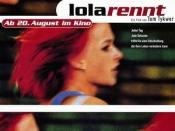The chosen sequence from "Run Lola Run" manages to incorporate various stylistic and editorial techniques into the short time span studied. (00.9.50-00.13.00)
In an attempt to portray the emotions of both 'Lola' (Franka Potente) and 'Manni' (Moritz Bleibtreu) combined with the introduction and reinforcement of one of the main themes of the film itself; the standard editing techniques available to any director have been put to great use throughout Run Lola Run. It is within this short sequence, however, that we can identify them as being extremely effective.
The sequence centres on a phone conversation between the two lovers, Manni and Lola, during which rhythmical editing is used in order to heighten the sense of emotion throughout their conversation. As the argument becomes increasingly heated, the shots subsequently become shorter in length. Tykwer utilises this fast cutting from character to character in order to boost the intensity of the scene and by managing to build a steadily increasing pace he therefore succeeds in making the viewer struggle to keep up and thus identify with the characters situation.
'In general, by controlling editing rhythm, the filmmaker controls the amount of time we have to grasp and reflect on what we see'
Specifically, this can be seen after Manni states:
"That's it, I'll rob the store!"
The words themselves are a clear indicator of the characters desperation but when combined with the general mise-en-scene (i.e.: the costume/makeup/props etc within Lola's flat and Manni's phone box) plus the applied editing techniques, we the viewesr begin to get a sense of the characters personalities - a vital point throughout the film.
After Manni's suggestion comes Lola's understandable reaction which begins the aforementioned shot to shot between characters in time with the conversation. Here we can see evidence of graphic matching between...


